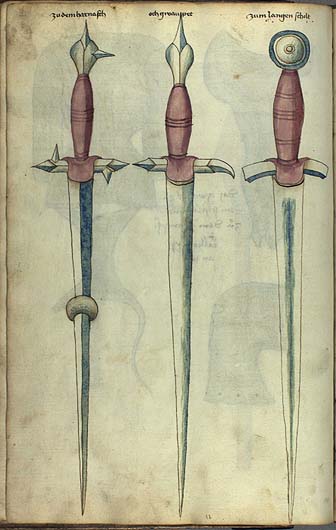ARMA
Editorial – April 2009
A Sword Story
 Imagine
if you would that there were no real handguns anymore. Imagine
if you would that there were no real handguns anymore.
Instead, there were only historical replicas of handguns.
But you love historical firearms and want to learn marksmanship.
So, you buy a replica and, lo and behold, the thing doesn't fire. It’s
only a shell, a gun-like object, with no working parts.
Then other replica models you find which do appear to work are way too
heavy to actually aim and fire.
You try to complain to the handguns makers. But they tell you they know
what they are doing. You have no choice but to accept that. At least a
few makers agree that replica handguns could be better and promise to
try to make them so.
Still other gun makers specialize in fake prop guns, where their owners
pretend they are shooting live rounds as they make “bang!” sounds
at one another (some even believing this teaches them about real marksmanship
with real firearms).
You get over your disappointment, make do with what you can, even using
foam and wooden guns to practice.
Then sometime later someone else starts selling pistols they say are
accurate “museum replicas.” Yay!
You start to practice shooting with them, taking them to the range over
several years.
But... the guns jam, they misfire, they’re inaccurate, and occasionally
they even explode in your hand. Their metal is generally too soft to accept
loading a round, plus a lot of the time the handles just break off.
Tsk, tsk. You complain but are told by the gun makers that the real historical
ones did all that too. Oh, you say, not realizing, and thus accept the
explanation.
But you inquire. How can they know how real guns should really fire if
they have no decent marksman among them who can shoot well? They tell
you this is not important, to just trust them, and meanwhile please buy
their new improved models.
Soon more handguns makes are on the market to meet growing interest and
the manufacturers assure everyone these are now the best ever. This time
they are truly accurate they tell us. (Which, apparently, wasn’t’
actually the case in the previous times they made that claim).
But then, a strange thing happens. You get to some museums of antique
firearms and are allowed to examine and even shoot with many specimens.
Then you do the same with ones in some private collections.
You compare them to the toy guns you know and the replicas you’ve
long trained with.
The result is a newfound appreciation for the qualities of the historical
originals and now you know much better what the attributes of real handguns
were.
Now you begin to spread this message to firearms enthusiasts who have
had the same questions and complaints about replica weapons that you’ve
had.
So, when you next complain to the gun makers, they start to listen.
They agree that more people want better guns and they again promise to
make them more accurate.
Other makers, however, suggest that if you just stop trying to fire their
guns there would be no problem. (Meanwhile, one or two of them starts
gossip about how you don’t really know good guns and are a poor shot
anyway.)
But when you try to apply what you have learned of marksmanship and evaluate
the newest handguns in comparison to the historical ones you handled and
fired, you quickly discover the new models won’t shoot straight,
won’t shoot very far, and when they do fire have no penetration.
Whoa...
That’s when you make a sudden realization.
You turn to the gun makers and say, “You guys really don’t
know about making accurate guns, do you?”
They stutter and stammer, hee and haw, then admit, “No, we don’t.
Sorry. But please don’t tell anyone.” They even say they really
do know how they could make real guns, it just would cost too much to
do right, and besides, since more people like wearing pretend guns when
they visit the Wild West Show that there’s no need to change everything
just for the benefit of a minority of informed firearms students.
Thankfully, you eventually meet some real gunsmiths who have learned
again how to hand-make quality pieces. They are further proof that the
originals were indeed fine weapons. They explain just how difficult a
process it is to make them properly, but reveal it can be done. They also
appreciate that to know if their weapons are truly accurate they have
to have a skilled marksman actually fire live rounds with them at different
things. They even want such feedback on their performance to help them
produce better weapons.
From this process you learn even more and truly become an expert shot.
Now the old shooting manuals make even more sense. But it’s only
possible because you had accurate replicas to learn with and the chance
to compare them with the real things.
The day soon comes that a new gun maker offers a line of accurate reproduction
handguns that work as good as the originals. They can do this now because
you helped educate and influence the industry. They even offer a line
of historically accurate practice guns that allow you to train safely.
Wonderful!
Everyone is happy.
Except the old gun makers.
Although they improve their product a little as a result, they now have
to compete with the fine replicas a more educated consumer is expecting.
Since they can't complete in quality or price they have to do it just
in marketing and advertising. But it keeps getting harder and harder to
do. And there they are, still telling people not to shoot with their guns,
or that when they misfire they are supposed to do that.
...Right.
|

